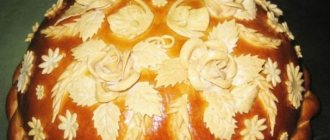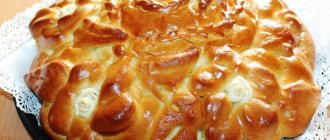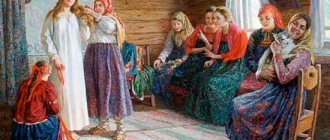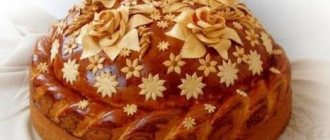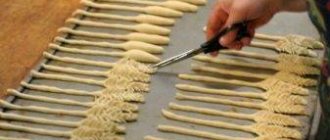This article has detailed information about the traditions associated with wedding loaves and cakes. Find out how pies used to be baked for wedding celebrations, what customs exist related to loaves and cakes among the peoples of the world.
The Slavs always knew how to feast cheerfully and actively. This is confirmed by facts from history and literary works. Wedding celebrations were always magnificent, regardless of the financial situation of the people. Already at that time, housewives followed traditions and baked a wedding loaf for the happiness of the newlyweds.
Now on the festive table there are wedding loaves and cakes. The latter are baked in multi-layers, decorated with exclusive roses and various details so that they are not similar to the others, but we are not talking about decorations for baked goods, but about the traditions associated with them among the peoples of different countries.
What is a loaf?
A loaf is a ritual bread, richly decorated, baked in accordance with special rituals, symbolizing wealth, happiness and well-being. What is the significance of a loaf of bread at a wedding? It is very difficult to overestimate the role of bread in the culture and life of the Slavs - “bread is the head of everything” , this parting word was left to us by our ancestors, and we observe ancient traditions and customs. Few people refuse this beautiful and very symbolic ritual - taking out bread when the newlyweds meet.
Photo of the wedding loaf
All this symbolism is embodied today in ritual bread for the young - that’s what the loaf is for. Previously, such bread was baked according to a special recipe only by married women with children. Widows , divorced or unmarried women were not allowed to participate in the bread baking ritual. Happiness in marriage, procreation - according to legend, women shared all this with the young, putting special energy into the loaf. Reading prayers, singing ritual wedding songs, special rituals for making dough and decorating bread became part of baking.
However, such bread was put into the oven by a married and happy man, thus, from those who prepared the loaf, the young people received, as it were, a particle of happiness and the ability to get along
Today, more and more often, one of the relatives buys a loaf in a specialized store or orders its production at a bakery. This approach is dictated by life itself, with its rapid pace and partial loss of some traditions. But for those who would like to bake bread with their own hands , there are loaf recipes that can help create a masterpiece of culinary and aesthetic skill with special energy and symbolism.
How did the ritual take place in ancient times?
Around the beginning of the 19th century, the custom of greeting newlyweds with a loaf of bread had already formed. It was done like this: on the eve of the wedding, the mothers of both those getting married got together with other women and did wedding baking. In other regions, special women, loaf makers, were invited for this purpose. They were definitely married, had children and lived happily in marriage. This was a prerequisite, because in this way, it was believed, they passed on a piece of their family happiness to their future husband and wife.
The dough for the loaf must be made according to all the rules:
- flour was necessarily taken from seven bags;
- water - from 7 wells;
- During kneading, prayers were sung, and only men put the bread prepared for baking into the oven.
How the loaf was decorated, symbolism
Wedding bread must be decorated with symbolic figures, which are designed to bring goodness and prosperity to the new family. These could be doves, as a symbol of love, spikelets, meaning fertility, swans - promising fidelity to the couple. They also put the dough on bread:
- braid - a symbol of the bride’s readiness to become a wife;
- viburnum branches - promising unity for the couple;
- rings are a sign of eternal love;
- spikelets - to wealth;
- the sun - to prosperity and abundance.
In some cases, the dough patterns were so ornate and abundant that it was often difficult to even understand what they wanted to depict there. But this did not upset anyone - the more, the better for the home and young family! A special depression for salt was always made in the center of the loaf.
Signs and superstitions: the family life of young people was often judged by how the loaf turned out.
- came out magnificent and tall - to share and prosperity,
- cracked in half - the marriage will not last long,
- the crust is burnt - the husband will be harsh,
- too flushed - the wife is careless.
The dough that remained from the loaf was also used. So-called cones were baked from it. They were often strung on sticks, placed on the wedding table in the form of bouquets, and then distributed to guests. It was believed that it was good to bring such an edible rose into the house and eat it with the whole family.
When the bread was baked, it had to be hidden under a wedding towel for the loaf, which was beautifully embroidered in advance, and not shown to strangers. The bride and groom (already married) had to bow to their parents, break off (bite off) a piece of bread and taste it. Then the father blessed the young people, they bowed to their parents and thanked them. It was believed that in this way the husband's family was ready to accept a daughter-in-law into the house.
Who should buy a wedding dress for the bride according to tradition?
Why do they count at a wedding when they scream bitterly and kiss?
How they met the newlyweds, what they said
Before the newlyweds returned to the house, the groom's parents stood on the threshold. The mother was holding a loaf on a towel in her hands, the father was holding an icon of St. Nicholas the Wonderworker. The parents had to make a solemn speech in which they necessarily wished the young people good, peace, happiness, many children and prosperity in the house. Examples of parents’ speech in several versions:
- Beloved children, today you have become a family, separated from your parents’ nest. May your path be smooth, like a wedding towel, and your life as sweet as this loaf! Let your relationship develop in the best possible way, and let God send you children for our consolation. Peace and prosperity to your family!
- Dear newlyweds, today you have become a family, and may peace and love always reign in it, may your bins be full, and may your wallets never be empty! We bless you with peace and goodness, happiness and prosperity!
- Happiness to your new family, peace to your home, many children, true friends, prosperity and prosperity for many years! Love each other, do not deviate from your marital responsibilities. Live in peace and respect, and raise your children too!
What did you do with the loaf after the wedding?
Traditions differed in different regions. Some, after biting off as young people, cut off half and gave it to the newly created family, and distributed the rest to the guests. Others divided it like this: the top for the young, the middle for the invited, the bottom with baked coins for the musicians.
Unmarried girls tried to take apart the decorations from the loaf; it was believed that if you put them under your pillow at night, you would dream about your betrothed. The part of the loaf left over by the young people was often kept dried for a long time, as a symbol of love and a guarantee of future family happiness. It happened that pieces of such bread were worn as an amulet.
Wedding loaf recipe
For the test you will need:
- 4 kg of wheat flour;
- milk - 2 liters;
- dry yeast - 100 grams;
- eggs – 6 pcs.;
- 2 tbsp. l. Sahara;
- 1 tsp. salt.
Photo of a loaf at a wedding
Process of preparing a loaf:
- Dissolve dry yeast in heated milk, add sugar and a few tablespoons of flour. Stir until the sour cream becomes thick, sprinkle with flour and cover with a towel.
- Wait for the dough to increase in volume and add the yolks, vegetable oil, the rest of the flour and salt. Knead the dough until it begins to pull away from your hands.
- Set aside 200 g of dough (for decoration), divide the remaining dough into four parts. Weave a braid out of three and form a ring from it; Fill the center with a quarter of the dough.
- For decoration, mold leaves, ears of corn, plant ornaments, and decorate the loaf with swans.
Bake the loaf on a sheet greased with vegetable oil, brushing the loaf with yolk before baking. Baking time: approximately 55 minutes at 170 degrees
Making wedding bread
Our ancestors attached great importance to preparing a wedding loaf. A married woman from the groom's family, who was happily married and had many healthy children, was entrusted with kneading the dough and baking the holiday bread. It was believed that with the bread she would transfer her positive energy to the newlyweds.
According to tradition, to bake a lush loaf, water was taken from seven wells, and flour from seven bags. The loaf was baked on the eve of the wedding, as large as it could be placed in the oven.
A strong, strong married man, faithful to his wife, was trusted to send the bread into the oven. This stage symbolized the process of conceiving offspring.
The finished wedding bread was hidden from prying eyes until the ceremony of welcoming the newlyweds in the parental home.
Serving a loaf at a wedding: an ancient tradition
Despite the change in the attitude of modern people to bread, you can buy a fresh product in any store; bread is still used as a ritual dish . At Easter, many housewives bake Easter cakes and ears of bread, fruit bread for Christmas and loaf for a wedding - this is more than just bread. Sacred symbols of important events and great holidays, they become an obligatory part of some rituals. Such bread was always skillfully decorated, and with certain symbolism. The beautiful Russian loaf is replete with various decorations. Each detail has a certain meaning and significance; many decorative elements are designed to appease higher powers, ask for a blessing or show your respect.
Photo of wedding loaf decorations
Bread for a wedding was always baked in a round shape - in honor of the sun, symbolizing happiness, life and goodness. A large wedding loaf was baked, because according to custom there were several stages of dividing the bread:
- The newlyweds were the first to bite into bread;
- the middle part was distributed to the guests;
- the lower part is for musicians;
- whatever was left was given to the poor waiting at the gate.
Thus, the young people seemed to share their happiness with those invited , whose gifts were gratitude for this benefit. Guests took pieces of the loaf home and shared it with their household, thereby sharing happiness. The newlyweds had to salt a piece of bread, thereby eating up all the salt of future tears, especially for the bride.
The bread was carried out on a towel - a beautifully embroidered towel.
The ancient Slavs called wedding bread a loaf - it was most often round, large enough bread to serve to all guests. A special meaning was invested in such a treat , since even special people were involved in its production, flour was ground on special millstones, and all this was accompanied by prayers and special rituals. It was a symbol of a happy life, prosperity and prosperity.
The loaf has not lost its relevance today . The groom's parents meet the newlyweds at the doorstep of the house with bread on a towel and icons, thereby blessing the young family for a long, happy life. The wedding ceremony does not set strict limits in this case. Some parents are holding bread, some are holding icons. Both parents say parting words.
Photo of a beautiful loaf
Not only the symbolism of decorations is important on wedding bread. On top of the loaf there is a place for a salt shaker . This can be simply a depression in the dough where salt is poured, and there is also a place for a salt shaker, which can be either glass or wooden with painting. They bring out a loaf of salt to the young people; it is not for nothing that in Rus' from time immemorial they greeted dear guests very magnificently and offered them a taste of bread and salt.
Today, the signs and customs that accompany a wedding say that whoever bites off the largest piece of bread will be the head of the family . Previously, girls did not strive for dominance, the husband was the breadwinner, the breadwinner, and it was he who was assigned this role, and the wife took care of the housework and children, but times have changed. You are also allowed to break off the loaf with your hands to take a piece for yourself.
The groom's parents greet the newlyweds with bread not only on the doorstep
This could be the wedding palace, the entrance to the restaurant or the beginning of the banquet. There are no strict rules here, so everyone decides where and how the bread will be taken out.
A loaf at a wedding means the first bread shared by the newlyweds. This is the first step of two young people starting their journey together. They have to live a long life, overcome many difficulties, and raise children. But at the beginning of this interesting journey is the wedding day and the first piece of bread together.
How many loaves should there be at a wedding?
Photo of a festive loaf
If there is a wedding ceremony, then there should be four loaves :
- The first loaf is baked for matchmaking. With this bread, the matchmakers go to the bride's house.
- Next, the loaf will be needed to bless the newlyweds after the bride ransom.
- The third bread is needed to meet the newlyweds after registration. This loaf is held by the groom's parents.
- The fourth is usually presented after the wedding ceremony.
History of the tradition
There are many opinions about where the tradition of welcoming newlyweds with a wedding loaf came from. International historians claim that this custom dates back to the times of ancient Egypt, but ours are sure that it originated in Slavic paganism many centuries ago. And our ancestors also have many versions regarding the loaf.
Bread and salt for dear guests
In ancient Rus', homemade bread and salt, which was then in short supply, were associated with prosperity in the home, and when dear guests were greeted with these two products, it was a sign of the deepest respect and veneration. In addition, salt in the house also served as a talisman against all evil spirits, and bread meant life. When a family had a lot of wheat in its bins, it meant that no one would die of hunger.
Around the barrel
The next version of the origin of the tradition with a wedding loaf comes from a time when people still did not have the opportunity to get married in a church. Everything happened simply - a wooden barrel was placed in the center of the hut, in which an adze was usually prepared, and freshly baked round bread stood on it. The newlyweds were led around the tub three times, and that was it, the marriage was considered concluded.
When Christianity came to Rus', churches and wedding ceremonies appeared, the tradition did not go away. But now young spouses who had returned from church were led around the barrel, thus welcoming a new family into the house.
Symbolism
Since our ancestors were pagans, they revered all sorts of gods who patronized certain areas of life, the round shape of the bread was dedicated to the sun god Yarilo. And because the heavenly body gives warmth, life on earth awakens from it, one can understand the veneration of this product in every family.
Loaf decoration
Delicious wedding loaves with decorations become one of the main wedding rituals. The breaking of bread , the deep meaning of eating the first piece together, becomes the main event for the guests. Bread for a wedding must be brought out with salt. A loaf salt shaker can be purchased and inserted into a special recess on top.
Bread decoration is of particular importance. So swans symbolize fidelity, ears of corn - prosperity, grapes - abundance and numerous offspring, a pigtail - the intertwining of the destinies of the young, doves are placed on a loaf as a sign of love and fidelity and symbolize the bride and groom.
Particular attention is paid not only to the towel and decoration on the loaf, but also to the utensils for bread
A loaf tray for a wedding can be a great memorable gift for newlyweds on the day of registration or wedding. The symbolism on such a tray will remind the young people of the happiest day of their lives.
The loaf should not only be beautiful, but also tasty. Previously, it was baked for several days using rye flour. Today it is usually rich bread made from wheat flour .
Meaning and symbolism
The ritual, when the parents of the newly-made husband brought bread to meet the couple, signified good wishes for happiness and a full home. It was by the presence of this product that it was determined how wealthy the family was and whether it could feed itself. Another meaning of the transfer was that the parents gave away part of their experience and shared their wisdom for the sake of the prosperity of the new generation.
The decoration that was located on top also carried certain symbolism. Rings woven together were considered traditional. Sometimes a pair of swans acted as a symbol of fidelity, but craftsmanship was required to make them. For this reason, it was believed that a similar sign appeared on loaves of rich families. The bread crust was decorated with ears of corn or patterns. The more there were, the more famous and wealthy the family, so at the wedding it was clear how lucky the bride was.
READ
Unusual wedding rings: original ideas and tips for choosing
Most traditions are not observed in modern times. Nowadays, to bake a loaf, you need to turn to professionals, but some families maintain the tradition of making one of the main symbols of the celebration on their own.
How much does a loaf cost for a wedding?
The price of a loaf for a wedding depends on whether you bake the bread yourself or buy a finished product. If you decide to order baked goods from a specialized place, the cost will vary within a thousand, everything will depend on the complexity of the decor and the weight of the product. If you decide not to give such an important point into the wrong hands, then its price will be minimal - only the amount that is needed to purchase the ingredients.
Mandatory loaf at a wedding
How they treat a loaf of bread after a meeting of newlyweds
After the ceremony of welcoming the newlyweds, the loaf is handed over to the godparents of the couple. They are the ones who treat all guests to wedding bread and offer to take a “piece of happiness” with them for relatives who are not present at the celebration. A guest's refusal of a piece of loaf is considered a manifestation of disrespect and dark intentions.
Rare shot: Viktoria Isakova showed her grown-up daughter from Yuri Moroz (new photo)
Why French children behave well: eight ways to raise them
It’s good to wash often: myths about shampoo and hair care that only harm
In some areas, the loaf was conventionally divided into three parts: the top was given to the newlyweds, the middle part was given to the guests, and the bottom was a treat for the musicians. Decorations in the form of braids, birds or ears of corn were distributed to unmarried girls.
However, not all newlyweds wanted to share their family happiness. In this case, after the ceremony, they did not offer bread to the guests, but wrapped it in a towel and ate a piece of it every day at home, believing that this way their young family would be stronger.
There is also a tradition of drying a piece of a wedding loaf and keeping it as a talisman. In ancient times, people took such a talisman with them on a long journey, believing that it would protect against possible troubles.


